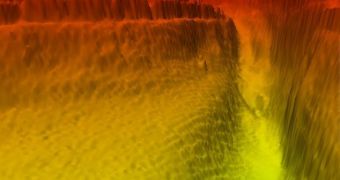During a nine-month mission whose goal was that of allowing the Royal Navy to gain a better understanding of the waters east of Suez, a ship dubbed the HMS Enterprise stumbled upon a so-called underwater Grand Canyon.
The crew aboard the HMS Enterprise made use of whatever technologies they had at their disposal to record the features of this underwater canyon, and later on resorted to a Devonport-based multibeam echo sounder to piece together several three-dimensional pictures of it.
In case anyone was wondering, this multibeam echo sounder works by sending out sound pulses and by using the echoes it gets back to produce images of the objects and forms found in its proximity.
Information made available to the general public thus far says that the canyon is roughly 250-meters deep (about 820 feet), and its now resting at the bottom of the Red Sea is most likely a result of this area's being crisscrossed by rivers several millennia ago. The Inquisitr quotes Derek Rae, the commanding officer of the HMS Enterprise, who reportedly made a case of how, “These features could be the result of ancient rivers scouring through the rock strata before the Red Sea flooded millennia ago.”
“Some may be far younger and still in the process of being created by underwater currents driven by the winds and tidal streams as they flow through this area of the Red Sea, carving their way through the soft sediment and being diverted by harder bed rock. Or there is always the possibility that they are a combination of the two,” commander Derek Rae wished to emphasize.
By the looks of it, the HMS Enterprise is to continue mapping the waters in this part of the world until this coming summer.
Commenting on their managing to present the general public with these stunning 3D images of the so-called underwater Grand Canyon, Commander Derek Rae stated that, “It is, however, almost certain to say that this is the closest that humans will ever get to gaze upon these truly impressive sights hundreds of meters beneath the surface.”

 14 DAY TRIAL //
14 DAY TRIAL //